
Streamline Moderne is an international style of Art Deco architecture and design that emerged in the 1930s. Inspired by aerodynamic design, it emphasized curving forms, long horizontal lines, and sometimes nautical elements. In industrial design, it was used in railroad locomotives, telephones, toasters, buses, appliances, and other devices to give the impression of sleekness and modernity.

The Greyhound Bus Terminal in downtown Evansville, Indiana, also known as the Greyhound Bus Station, is a Streamline Moderne-style building from 1938. It was built at a cost of $150,000. Its architects include W.S. Arrasmith who designed numerous other Greyhound depots. The terminal, at the corner of Third and Sycamore streets, was listed on the National Register of Historic Places in 1979.
The University of Arkansas Campus Historic District is a historic district that was listed on the National Register of Historic Places on September 23, 2009. The district covers the historic core of the University of Arkansas campus, including 25 buildings.

The Greyhound Bus Depot is a former Greyhound Lines intercity bus station in Columbia, South Carolina. It is at 1200 Blanding Street in downtown Columbia. The depot was named to the National Register of Historic Places on December 28, 1989. After the bus terminal was closed, the building became a bank. Currently, it is a physician's office.
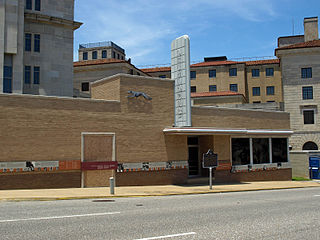
The Freedom Rides Museum is located at 210 South Court Street in Montgomery, Alabama, in the building which was until 1995 the Montgomery Greyhound Bus Station. It was the site of a violent attack on participants in the 1961 Freedom Ride during the Civil Rights Movement. The May 1961 assaults, carried out by a mob of white protesters who confronted the civil rights activists, "shocked the nation and led the Kennedy Administration to side with civil rights protesters for the first time."

The United States Post Office Canal Street Station, originally known as "Station B", is a historic post office building located at 350 Canal Street at the corner of Church Street in the Tribeca neighborhood of Manhattan, New York City. It was built in 1937, and designed by consulting architect Alan Balch Mills for the Office of the Supervising Architect of the United States Department of the Treasury.

Wheeling Warehouse Historic District is a national historic district located at Wheeling, Ohio County, West Virginia. The district includes 20 contributing buildings and 11 contributing structures. They are warehouses and commercial style buildings and structures between Main Street and the Ohio River. All of the buildings date to the late-19th and early-20th century. The warehouses are mostly two- and three-story masonry buildings. The two-story commercial buildings have storefronts on the first floor and residential units above. Notable buildings and structures include the Pump Store (1933), Wheeling Stamping Plant (1932), Allied Plate Glass, Warwick China, Boury Warehouse, Ott-Heiskell Company, Edward Wagner Wholesale Grocers building (1915), the Moderne style former Greyhound Bus Station, and Main Street Bridge (1891).
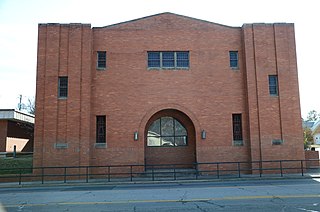
South Side Baptist Church is a historic Southern Baptist church at 2400 Dodson Avenue in Fort Smith, Arkansas. It is a large two-story brick building, built in 1948 with Moderne styling. The main facade is symmetrically arranged, with its entrances recessed to the sides of a round Romanesque arch, whose rear wall presents a round-arch window. Narrow windows and projecting corner sections relieve the mass of brickwork, with the corner sections providing vertical emphasis with piers and rising the height of the building. The building is a rare local example of the Moderne style. It is used by the church for educational facilities.
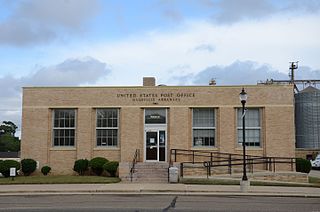
The Nashville Post Office is a historic post office building located at 220 North Main Street in Nashville, Howard County, Arkansas.

The Blytheville Commercial Historic District encompasses most of the central business district of Blytheville, Arkansas, one of the TWO JUDICIAL DISTRICTS of Mississippi County. It extends along Main Street between 5th and Franklin Streets, and along Ash Street between 5th and 2nd. Most of the 39 buildings in the district were built between 1890 and 1956, in three phases of development. The two oldest buildings in the district, both dating to c. 1890, are at 112 West Main and 106 East Main. The building traditionally viewed as the anchor of the downtown area is the Kirby-Heath building at the corner of Main and 2nd, built 1901.

The Blytheville, Leachville and Arkansas Southern Railroad Depot-Leachville is a historic railroad station at the junction of 2nd and McNamee Streets in Leachville, Arkansas. It is a single-story wood-frame structure, with an asphalt roof and wide overhanging eaves. The telegrapher's station is in a small projection on the track side of the building. The station, which provided both passenger and freight service, was built in 1910 by the Blytheville, Leachville and Arkansas Southern Railroad, a small regional railroad seeking to provide additional means for area farmers to bring their products to a wider market.

The Kress Building is a historic commercial building at 210 West Main Street in Blytheville, Arkansas. It is a two-story concrete and steel structure, faced in brick and terra cotta. Built in 1938, it was one of the first buildings in the city to be built using steel framing, and is one of its finest Art Deco structures. The first floor areas are faced in terra cotta, while the second floor is predominantly cream-colored brick. Windows on the second floor are surrounded by ivory terra cotta incised with fluting and shell patterns.

The West Main Street Residential Historic District of Blytheville, Arkansas, encompasses a seven-block residential stretch of West Main Street, which presents a well-preserved history of residential development during the first six decades of the 20th century. This time period includes Blytheville's most significant period of growth, which began with the arrival of the railroad in 1900. Most of the buildings in the district are residential wood-frame structures, one and two stories in height. Most of the buildings, including some that are no longer historically significant due to later alterations, were built between 1900 and 1930. Stylistically, the district includes a cross-section of architectural styles popular in the early 20th century, although there are a significant number of vernacular structures. The district extends from North 6th Street to Division Street, and includes fifty buildings, of which almost all are residential.
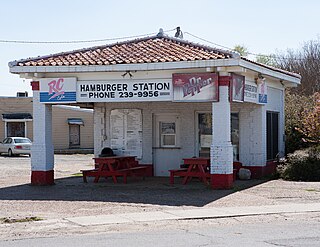
The Texaco Station No. 1 is a historic automotive service station at 110 East Main Street in Paragould, Arkansas. Built in 1925, it is a Mission-style brick building with a canopy extending to cover the service area. It is one of only two surviving early gas stations in the city, and was used as a service station until about 1970, going through a number of ownership and fuel supplier changes. In 1985 it was converted into the Hamburger Station, a restaurant.
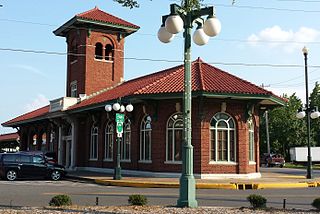
The Missouri-Pacific Railroad Depot-Hot Springs is a historic former railroad station at Broadway and Market Street in Hot Springs, Arkansas. It is a single-story masonry structure, roughly V-shaped due to the triangular parcel, with a tile hip roof with broad eaves supported by Italianate wooden brackets. A Tuscan tower rises above the station, and its walls consist of bays of compound round-arch windows. The station was built c. 1917 by the Missouri-Pacific Railroad, and is a major reminder of the importance of the railroad to the growth and success of Hot Springs as a resort community.

William Strudwick Arrasmith was an American architect known for his designs for Greyhound bus stations in the Streamline Moderne style popular in the 1930s and 1940s. Among the over 60 stations he designed are the Cleveland Greyhound Bus Station (1948), the Montgomery, Alabama, Greyhound Bus Station (1951), and the Evansville, Indiana, Greyhound Bus Terminal (1938) which are listed on the National Register of Historic Places.

The Greyhound Bus Station at 219 N. Lamar St., Jackson, Mississippi, was the site of many arrests during the May 1961 Freedom Rides of the Civil Rights Movement. The Art Deco building has been preserved and currently functions as an architect's office.
William Nowland Tom Van Powell (1904-1977), sometimes known professionally as William Van Powell or Nowland Van Powell was an architect, painter, and historian from Memphis, Tennessee.

The Greyhound Half-Way House at 124 E. Main Street in Waverly, Tennessee is a building formerly operated by Greyhound Lines as a Greyhound Half-Way Station.
George D. Brown was a 20th-century architect who designed several historically significant bus stations for Greyhound Lines, including the Greyhound Bus Depot and the Atlantic Greyhound Bus Terminal station in Savannah, Georgia. Both of these stations are listed on the National Register of Historic Places for their architecture.



















